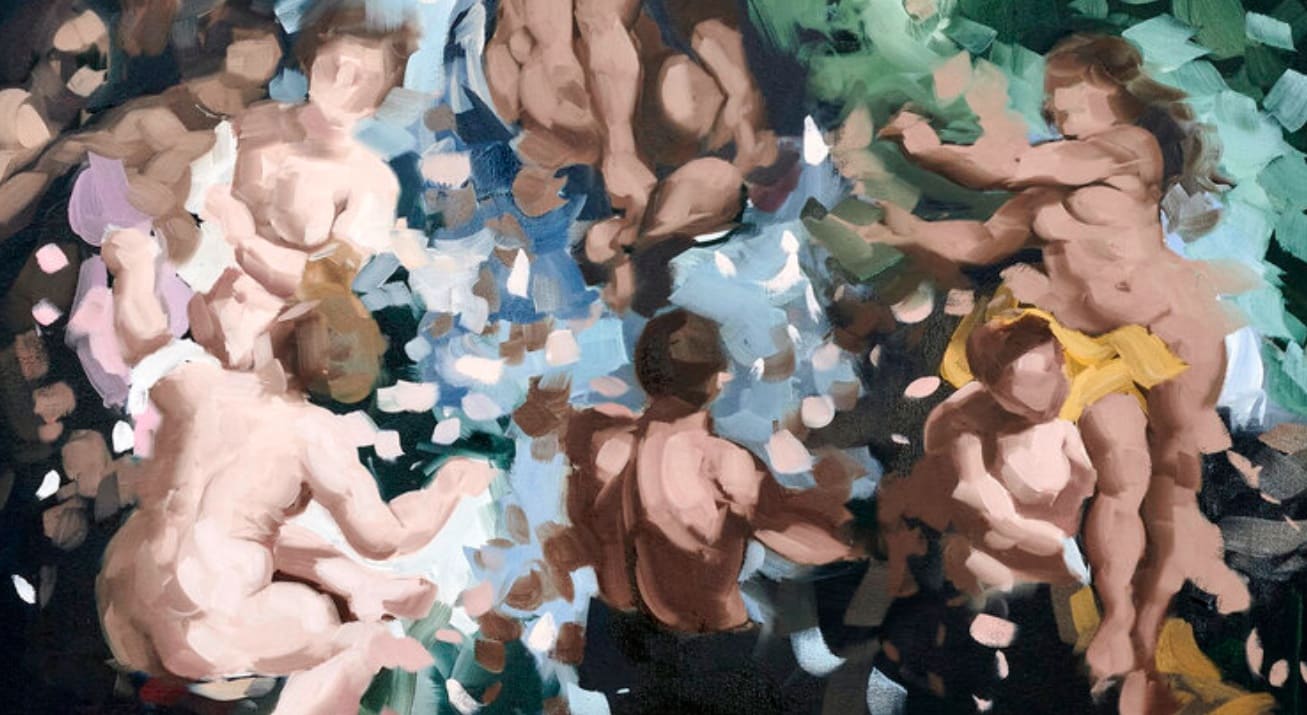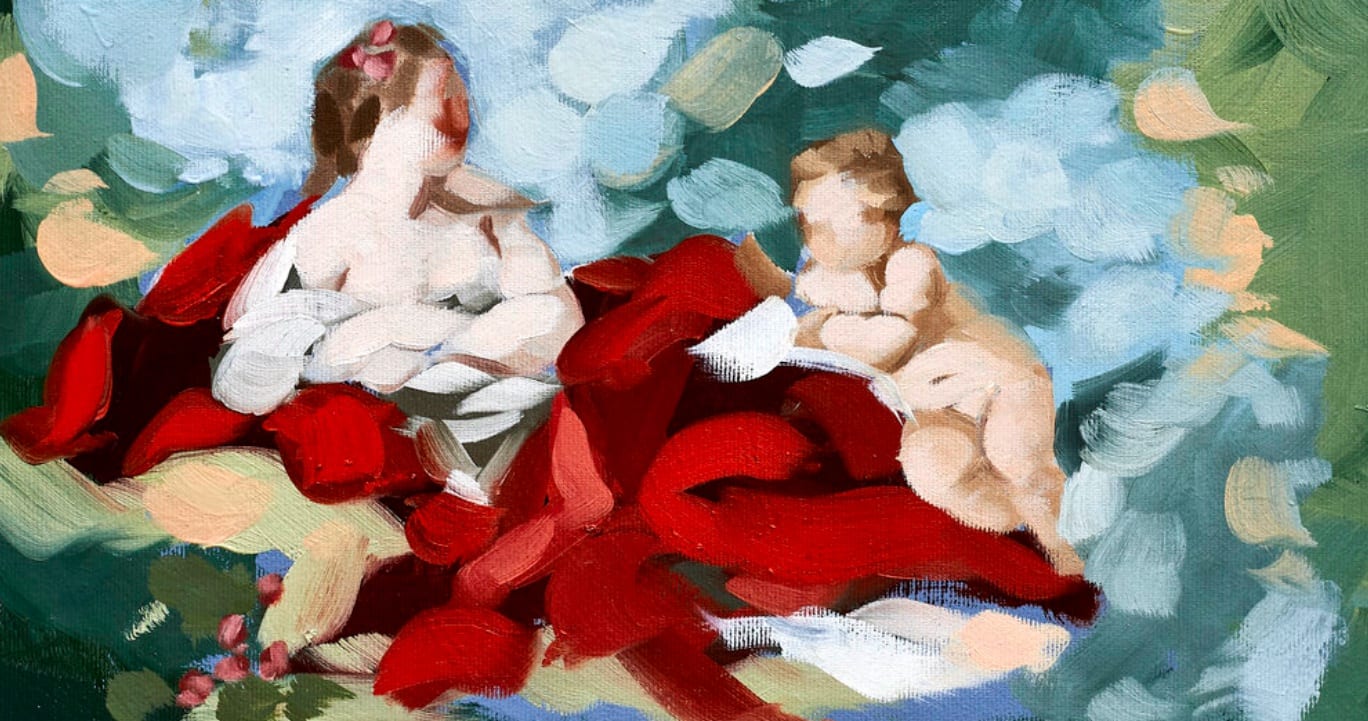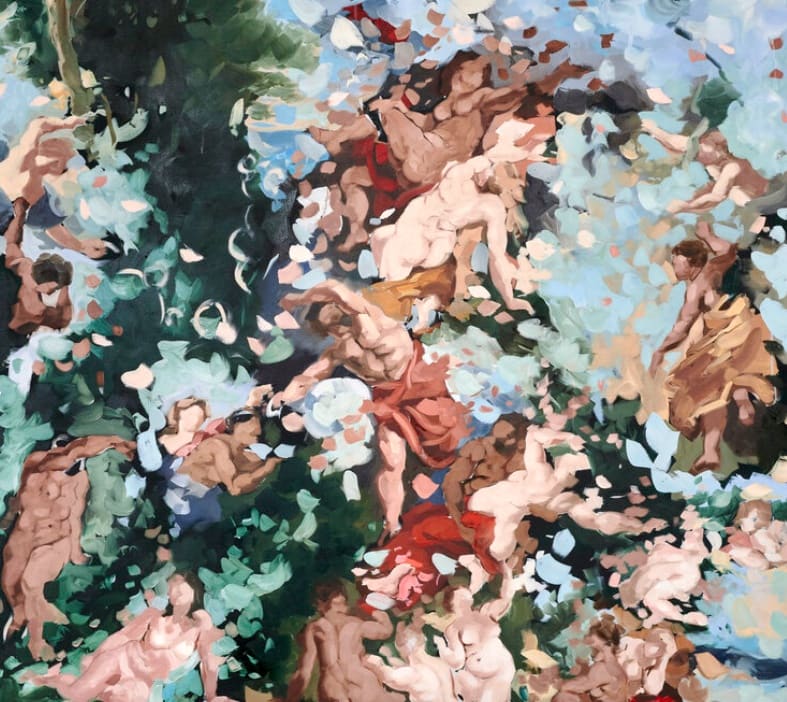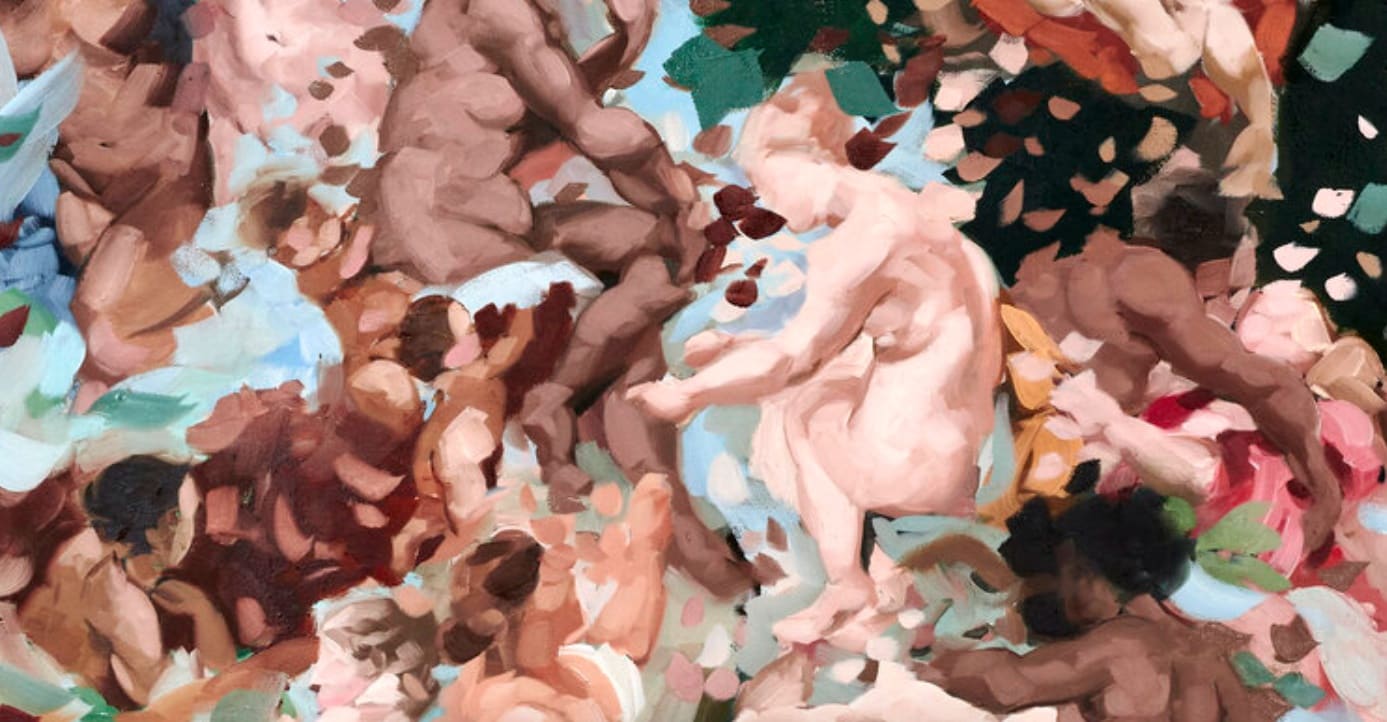ELEANOR JOHNSON
@ELEANORJOHNSONSTUDIO
I love Eleanor Johnson’s work, and have followed her fabulous and explosive career closely!
"The oil paint takes a while to dry, so you can manipulate it and blend it and work it to your hand. It often feels like alchemy or magic – oil paint has so many possibilities! I find it easier to get lost in the process of painting if I work fast. And I like that slightly unconscious, ungrounded state of mind that sometimes is reached. It reminds me of being in a “dream bubble” or an un-lucid state, a psychological space that interests me and I like to channel into my work.”
Find below our 2020 Interview, and our 2021 Interview done ahead of our exhibition with the Gillian Jason Gallery - Heart of the Matter.
-
INTERVIEW
2021
How would you describe your artistic practice in three words?
Liminal, nostalgic, and metamorphic
What issues do you believe need to change or be challenged in the art world?
Art can be a difficult profession to venture into. Financially, it can be a burden, as most artists have to pay for studio space, materials, and put money towards exhibitions. Art school, which can also be an incredibly helpful experience, simply isn’t affordable to many people. All of these things make it simply impossible for some people to fully apply themselves to becoming an artist, which is sad, and also detrimental to society as the world needs art and artists, despite what some people may think! I think there should be more funding to help artists stay afloat, far greater representation of Ethnic Minority and Deaf and Disabled artists, and more opportunities for emerging artists to show their work publicly without “breaking the bank”.
It’s amazing how galleries and museums have adapted during the pandemic, to allow their collections to be seen online. However I hope that they are helped back onto their feet once restrictions are slowly lifted, as I think the physical viewing of artworks is so important both for education and mental health (to name only a couple of benefits), especially in our day and age. I’d love to see the art world develop and grow to be even bigger and better, but also more inclusive and accessible than it has been up until this point. -
WHAT IS YOUR STUDIO LIKE?
My quiet studio is in the middle of a large building. It doesn’t have any windows except a big sky light – so it feels very private and cocooned, which I love. I really like being alone when I’m painting. Sometimes my dog is with me who dozes for most of the day, and it’s really nice to have her there for company.
I’m quite particular when it comes to the environment that I paint in. I prefer the space to be organised and clear, as too much clutter can stress me out. When I arrive, I like to put myself in the right mindset, so I’ll light a candle and some incense, and just sit or lie on the floor for a bit. Living in a sometimes overstimulating city, this is a great way to physically ground myself and leave everything outside the room behind. On an ideal week, I’ll leave emails and admin work to do on the weekend, so that during the week I can just focus on painting.
I’ve also realised that I paint best when I’m multitasking. I heard somewhere that certain people work better this way. I think it has something to do about stimulating a certain part of your brain, which helps with whatever you’re actually focusing on. So I listen to podcasts all day, as I love learning new things. My absolute favourite podcast at the moment is “I Weigh” with Jameela Jamil. She interviews inspiring and pioneering people, with a focus on the experience of shame and how it affects us (which is where my work stems from), and she doesn’t shy away from taboo topics. “Witch, Yes” is another fabulous podcast in which Alicia Herder and Terra Keck discuss the many different strands of Witchcraft, in a very funny, warm and informative way. There are so many others but I don’t think I have room to mention them all!
Also, when I go back to my family home in the countryside, there’s a little hut overlooking a small stream amongst some old trees that I like to work in. It’s amazing there, as you’re entirely surrounded by the sounds and sites of nature, which is so peaceful. My relationship with nature is such a big part of my work, and there, I feel like it’s restored.COULD YOU TELL US A BIT ABOUT THE ARTWORKS YOU HAVE IN ‘HEART OF THE MATTER’?
I’ve loved doing these paintings and they’re a slight departure from the work I have been doing up until this point. Each is loosely based on visual excerpts from Celtic Mythology, which I’ve recently fallen in love with. I was drawn to this strand of mythology as a way of exploring my Gaelic Heritage, but also because of its dreamlike and fantastical narratives.
I have a very vivid dream-life, sometimes so much so that the line between dreams and reality is often blurred for me, and I can forget what was a dream, and what was real. Feelings from my dreams can linger for days, and I experience lots of strange psychological experiences when I’m on the verge of sleep too, such as sleep paralysis and hallucinatory dreams. I wanted to channel some of these experiences and their liminal, uncanny nature into my paintings.
I also practise witchcraft and have been bringing some of it into my studio in recent months. These paintings were a product of this. Some of my methods include the use of Sigils, which are self-designed inscribed symbols with energetic power, and ritual.
WHO ARE YOUR ART WORLD ROLE MODELS OR MUSES?
My brothers are my muses – they have always inspired me and encouraged me, and I’m infinitely proud of all of the work they do. Tom is a photographer, @tomjohnsonstudio, and Sam is a film-maker and director, @samjohnsondirector. My partner Gabriel, @gkennyryder, is my third muse, whose photographic installations are beautifully ethereal and mystical. My final muse, who doesn’t have an Instagram account, is Leonora Carrington. She was a Surrealist artist, and has only recently been rediscovered and appreciated for the incredible work she made. She was an artistic genius, a rebel, and a very strong and independent woman. I’d say she’s one of my biggest role models, besides my amazing, hardworking and artistic parents who are also my best friends and number one heroes.
-
-
INTERVIEW
2020
What made you decide to follow a creative career choice? Was it ever in question? Or was it inevitable?
I could never imagine doing anything else! When I’m not doing something creative, I feel this pressing sense of loss. I’ve definitely doubted my ability lots of times, and have made a ton of mistakes already - but am learning new things every day. There’s an endless pool of inspiration out there and I get excited when I think about the future and what I’ll be making next.
What was your earliest memory regarding art?
Filling in colouring books of horses with a good friend while dunking bread into bowls of hot chocolate, in Brittany, Northern France.Tell us about your process? How does each work come to fruition? Your paintings almost look like collages… tell us about your technique?
I like to work quickly, and avoid getting too focused on detail. I like my paintings most when they have a looseness and a fluidity, so I find that keeping planning to a minimum works well for me. I start by rapidly “drawing” the outline with my paintbrush using acrylic paint, which dries quickly, and then I use oil paint to add in swathes of colour. The oil paint takes a while to dry, so you can manipulate it and blend it and work it to your hand. It often feels like alchemy or magic – oil paint has so many possibilities! I find it easier to get lost in the process of painting if I work fast. And I like that slightly unconscious, ungrounded state of mind that sometimes is reached. It reminds me of being in a “dream bubble” or an unlucid state, a psychological space that interests me and I like to channel into my work.
I take a heavy dose of inspiration from Old Master paintings, but like to dismantle them – rejigging compositions, while mixing them with images of my own. Photography plays a significant role in my process. I like to photograph life models and friends with a large format camera. This adds a nice hint of the contemporary, bringing the painting into the present moment. So it’s an amalgamation of classical and modern. I’d love to exhibit some of my photographs alongside my paintings in future exhibitions.
I guess they come to fruition sort of like lightbulb moments – I sort of see it in my mind and then just go for it, compiling various images together and then working by instinct. Walking in gardens or in outside spaces seems to encourage these moments!
Your work is so tender, and loose. Eleanor, how do you know when a piece or project is finished and needs no additional work?
It’s definitely instinctual. I like the piece to be in that sweet spot between absence and presence, and once I think it’s in that place, I leave it. Maybe add a few highlights here and there. I also like to look at its reflection in a mirror, and that will help me see if it’s balanced or not.
Tell me Eleanor, what are your ideal conditions to paint? What is your studio like? And what are your artist essentials to work?
I like to be free from online distractions, so I’ll get my emails etc done before getting my paintbrushes out. Then I’ll put on a podcast or some music which helps me to not really think about what I’m doing, which then helps me to avoid getting too “precious” with the painting. I try not to get too attached to any areas of the painting, to avoid overworking it, so being in this slightly unconscious place is really good for my practice.
I try to keep my studio uncluttered, and keep the images taped to the wall to a minimum (only the images I’m working from at any one time). This helps with a bit of mental clarity as I’m not so good with visual overstimulation (other than in my paintings)! I put all of my inspiration into scrapbooks, which I’ll look at if I get stuck.
I love that.
I like to light some incense and a candle or two, and create a calm environment and then I can get going. It sounds so fussy – but I need things to be a certain way. Artist essentials include a coffee or two in the morning, some food to keep me going, my baggy overalls, and my lovely dog Bluebell being somewhere nearby to keep me company.
What 3 words would you use to describe your work?
Hypnagogic, fluid, joyful.
What has been the highlight of your career so far?
Definitely being commissioned by Burberry for their “Inside Nature” project. They contacted me during a personally challenging time, so it was a wonderful opportunity for distraction – and I was flabbergasted and very flattered to have been asked! Nature has always played a big role in my life – my parents run a garden centre and we’ve always lived in the countryside – so it was an added bonus that the project focused on this.Who or what is your greatest inspiration? How does this inspiration come out in your work?
Peter Paul Rubens was the first artist to come to mind.
I can so see that!He paints monumental idyllic scenes of mainly groups of people frolicking in nature. The paintings make me think of a dream world, or another world filled with mythical creatures, or of a time long ago in which people were one with the world and nature. The breadth of his imagination is astounding – and it gives me hope in my own work that anything is possible if you let your mind have fun and feel brave enough to push the limits beyond what you’d think you were capable of making. His rendering of flesh has been admired by many contemporary artists, for good reason. He shows the complexity of the body, and painted a whole range of body types. He wasn’t all about flattery, but often depicted truthful representations of people. His compositions are fluid and teaming with life, and sometimes there’s so much going on that you could look at one painting for hours. I like this particularly about his work – that they are visually overwhelming. I remember the first time seeing some of his paintings in London when I was much younger – and thinking they were the best things I had ever seen.

Eleanor, bearing in mind my answer would probably be one of yours! If you could own one piece of artwork in the world, as if money or likelihood was no issue, what would it be and why?
Haha. One of Michalenagelo’s or Raphael’s sketches/drawings. These two artists are my second biggest inspirations. Their paintings are beautiful, but I particularly like their preparatory work. They have an energy and a frenetic nature that keeps me going back to study and look at them. They’re disjointed and sometimes slightly incomprehensible, which leaves a lot to the imagination. Your eye moves over the surface of the paper, trying to figure out what’s going on. You can see the workings of their minds in their pencil work, as lines have been discarded and left instead of being erased. “The Death of Meleager”, one of Raphael’s drawings on which his painting “The Deposition” was based, is a good example of this.
What is creativity to you? Do you consider yourself to be creative? Why or why not?
I think creativity is about having fun and being brave. I would say I’m creative, but there are so many different types of creativity! I like my paintings to be “all over the place” visually, almost chaotic. But I would consider most other visual/creative things in my life to be quite minimal and controlled. I like organized, clear interior spaces with a focus on detail, whereas the way I dress is often in a particular style with a limited range of colours (whites, blacks and occasionally reds). Creativity is so vast – so I guess mine is varied and contradictory!
What is your greatest indulgence in life?Finding antique or second hand furniture, clothing and art, and indulging in purchasing something if I can afford to!What are your words of wisdom for someone starting out in your field?
Don’t be afraid to break the rules. It usually means you’re moving in the right direction.
What are you working on at the moment?
I’m about to do a new body of work for a gallery in London in a similar vein to paintings I’ve been doing recently, showing people in nature, à la Rubens. I’m also working on a number of commissions and may be collaborating with a lovely clothes brand in Paris soon.
What is your ultimate dream project?
This is a big dream, but I’d like to take over a group of old buildings in Italy and paint murals on the interior walls in their entirety. I’d also love to do vast exhibitions in interesting, sprawling exterior spaces in Italy, Greece and France.Favourite historical female artist?
I can’t name just one, so, Leonora Carrington, Dorothea Tanning, Francesca Woodman, Diane Arbus, Joan Mitchell, Nancy Spero and Eva Hesse.Favourite current practicing female artist?
Cecily Brown.Is there anything else you wanted to say?
Yes, Charleston (https://www.charleston.org.uk/) has been financially devastated by the Covid-19 pandemic, and is currently taking donations to support it, and save it from falling under.
It’s an absolutely wonderful and unique place where the Bloomsbury set lived and worked, and it would be very sad to see it go.
https://www.charleston.org.uk/charleston-emergency-appeal/









